- Region Summary News
- 25th Anniversary
- 2011-2013 and Beyond...
- Participate
- testing
- Photos: World Oneness Aspiration Themes
- Torch-Bearer Award
- Videos
- Friends
- UN Initiatives
- Media
- Year - Rapprochement of Cultures
- Davidson Hepburn Message
- Other IYRC Messages and Statements
- Examples of IYRC at Events
- Living in Harmony - Summer Camp Curriculum
- IYRC Logo: 6 Languages, Multicolor strands and symbol
- Sample Handout - Message, Song Music, Country list, Photos
- IYRC Talking Points and FAQ
- "How to" show IYRC at "Live from Road" news
- Schools And Kids
- Song
- About
- Asia Pacific
IYRC Logo: 6 Languages, Multicolor strands and symbol
The 6 languages , muticolor strands and symbol the year 2010 IYRC logo.
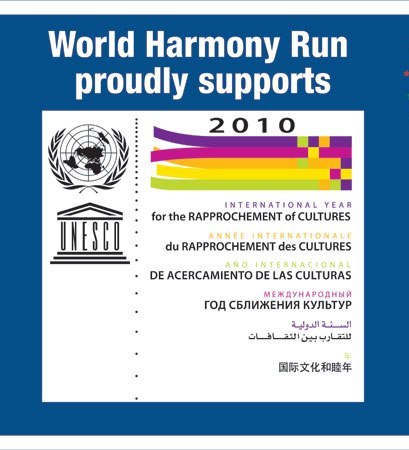
Languages:
6 Official Languages
The 6 Official languages of the United Nations on WHR Banner appear as part of the 2010 logo in this order: English, French, Spanish, Russian, Arabic, Chinese, (More about 6 official languages below at NOTE:*1*)
At some events the Languages are identified and individuals have come forward...
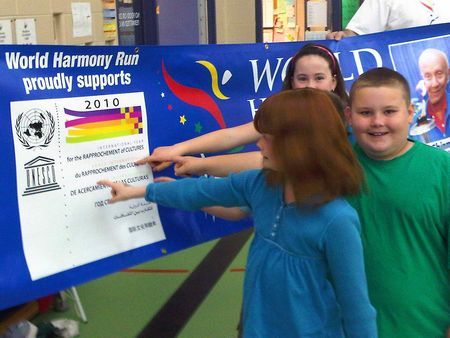
- to point out or read a phrase from the language.
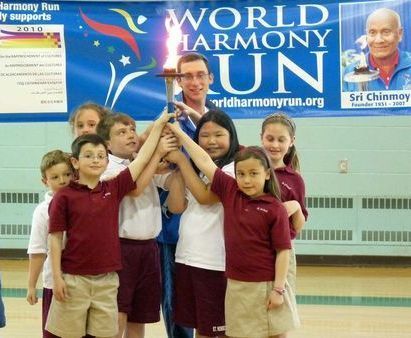
- And then to hold the World Harmony Torch together. In this event seven children who participated in the language identification exercise held the torch together with a team member fluent in the first two of the six languages.
Other Languages:
It has been noted at some programmes that on the banner for the year there is room for additional languages after the 6th language. This could be used to represent the language of a host or visiting country or group. Also arrangements could be made to display more languages or dialects beside the banner if a local county or other group felt it may be useful.
Introducing the Logo for the year also provides a opportunity to mention special local or regional languages:For example:
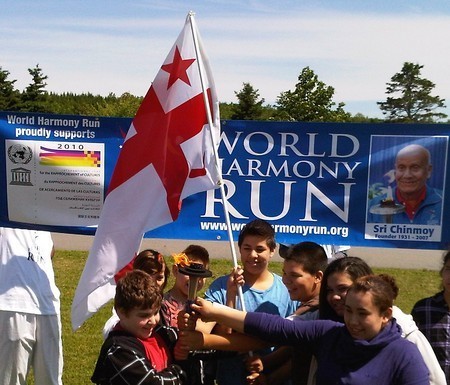
While the harmony Run was in Nova Scotia, we were delighted to have some students who knew the regional Mi'kmaq language come forward with their flag to hold the torch together.
International Mother language Day
Noting the 6 UN official languages on the banner and the many other languages in the world also provides an opprotunity to mention International Mother Language Day. The day is Celebrated each February. It is a day dedicated to promoting linguistic and cultural diversity and multilingualism. It was proclaimed by UNESCO's General Conference in November of 1999.
For information and related resources:
- UN site : http://www.un.org/depts/dhl/language/.
- UNESCO site: http://www.unesco.org/en/languages-in-education/
2010 NY event: An event on 23 Feb 2010 was hosted by the Society of Foreign Consuls of New York to celebrate International Mother Language Day. We were honored to present the Torch-Bearer award to the society's President, H.E. Christoph Bubb, Consul General of Switzerland for the society's work in promoting international understanding and cooperation. Vice-President Hon. Mohammed Shamsul Haque, Consul General of Bangladesh shared the torch with the President as part of the acceptance ceremony. Link to International Mother language Day Programme in NY for 2010.
Language Choice: see also NOTE (*2*) below: Example of two countries where Language choice had historical impact:
Multi Color Strands and Symbol
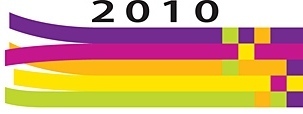
Unique Colors - Make up the whole
At the top of the logo for the year 2010 there are many different color strands which join together at one end to form a symbol, yet each strand keeps its unique color to make the whole.

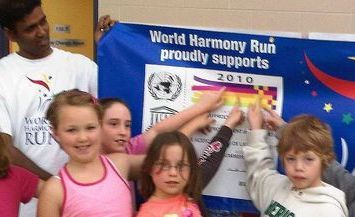
This symbolism was especially appreciated in multiethnic and multiracial communities.
(*1*) Notes on Languages:
- Explanation of 6 Official UN Languages
An international organization must have effective ways to overcome language barriers to avoid becoming a Tower of Babel. Since almost every country in the world is represented at the United Nations, it is not an exaggeration to say that the United Nation is a microcosm of the world. The Organization uses six official languages in its intergovernmental meetings and documents, Arabic, Chinese, English, French, Russian and Spanish; the Secretariat uses two working languages, English and French.
Statements made in an official language at a formal meeting are interpreted simultaneously into the other official languages of the body concerned by United Nations interpreters. If a delegation wishes to speak in a language that is not an official language, it must supply an interpreter to interpret the statement or translate it into one of the official languages. It is then rendered into the other languages by a relay system.
Documents are produced in the six official languages and are issued simultaneously when all the language versions are available.
exstract from: http://www.un.org/Depts/DGACM/faq.html
see also :
- Rules of Procdeure of the General Assembly VII. Languages (official and working) rule 51 - 57: http://www.un.org/ga/ropga_lang.shtml
- Introduction to Rules of Procedure ( introduction paras. 5 {1948-Spanish working L. added}, 27 {1968 Russian working L. added}, 28 , 34 {Chinese working L. added, Arabic official and working L. added} and 40) http://www.un.org/ga/ropga_intro.shtml
(*2*) Example - Two countries where Language choice had historical impact:
WHR team has visited memorials at both locations.
Bangladesh:

The war of Liberation started in 1971. But the seeds of the movement to gain independence began "through the struggle for the honour of the national language, Bangla in 1952",- from explanation at National Martrys Memorial in Bangladesh:
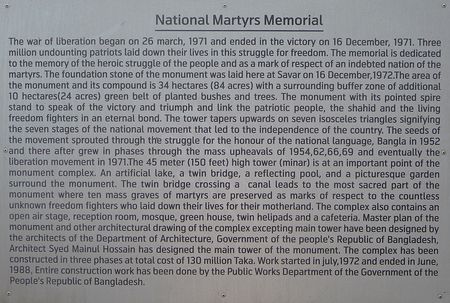
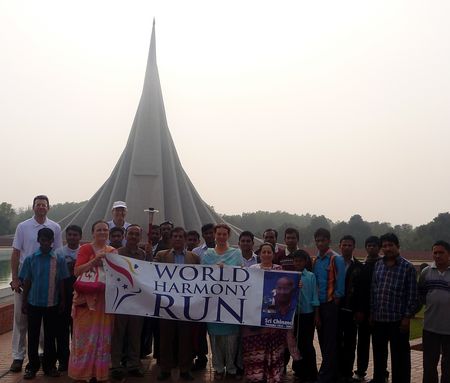
- World Harmony Run team members held the torch with local people visiting the memorial and
- The team sang WHR Theme song -We are the Oneness and Fullness of Tomorrows Sun". http://www.worldharmonyrun.org/song
South Africa- Soweto
-
Mouyisa Makhala Primary
Excerpt from 2008 report. For a full report of the day see: http://www.worldharmonyrun.org/sa/news/2008/1022
One of the great symbolic landmarks of Soweto is the Hector Pieterson Memorial – a memorial to the school child killed on this spot in demonstrations in the 1970s. (see historical note below)
And across the road – Mouyisa Makhala Primary.
Here the students wait for us, seated in neat rows, in the shade of several trees.
We all admire the teachers here –their obvious concern for and dedication to their pupils, and their enthusiastic support of the World Harmony Run.
All the children touch the torch and make a wish for peace and world harmony. Girls recite poems, Desmond from Zimbabwe reads us his poem on friendship.
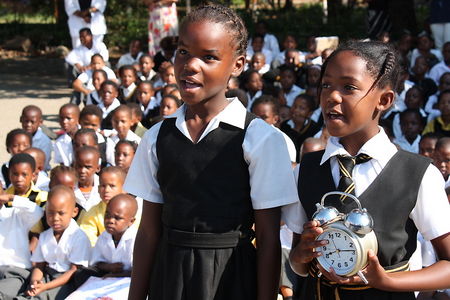
We run out of the school onto the dusty, streets of Soweto buoyed up with hope for a harmonious future growing here with these children and their teachers.
-
Shomang Primary School
The ceremony at this school begins with a long prayer that all five or six hundred pupils recite, eyes closed, standing in the dusty area between the rows of simple brick classrooms. Ondrej from the Czech Republic leads the Harmony Run presentation.
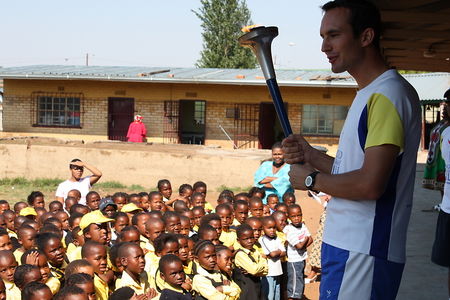
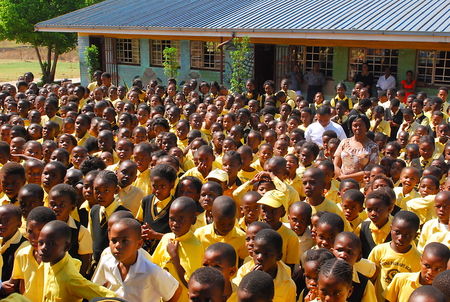
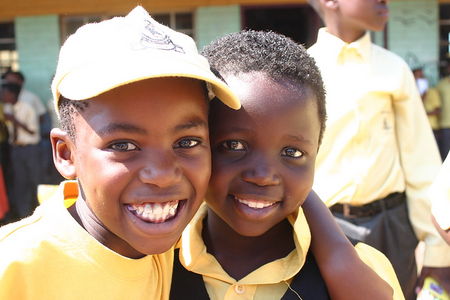
After a photo of the staff with the harmony torch, the head teacher sends the team on its way with – “Keep running, keep running! Close the gap!”
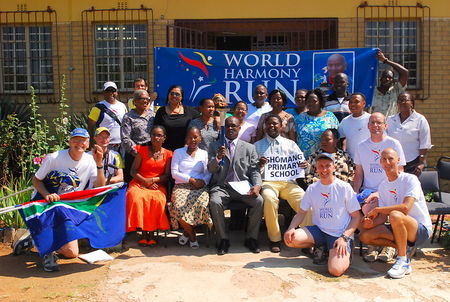
And so we run on out of Soweto.
Note: The Day of the African Child is celebrated on June 16 in recognition of the day when, in 1976, thousands of black school children in Soweto, South Africa, took to the streets to protest the inferior quality of their education and to demand their right to be taught in their own language. Hundreds of young boys and girls were shot; and in the two weeks of protest that followed, more than 100 people were killed and more than 1,000 were injured. (http://www.unicef.org/media/media_40005.html)
To eee different ways the 2010 International Year has been introduced during World Harmony Ceremonies.
Print parts in PDF format: http://www.worldharmonyrun.org/unesco_year/iyrc_examples/pdf_downloads






















